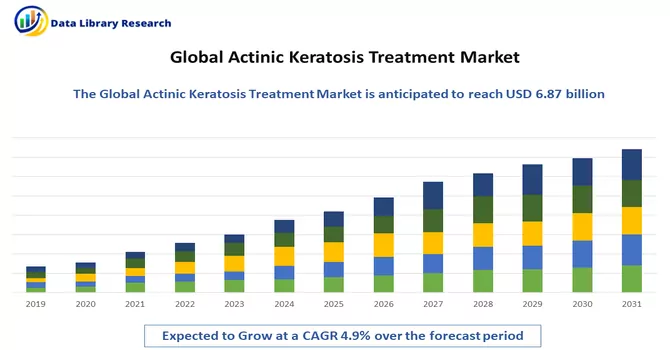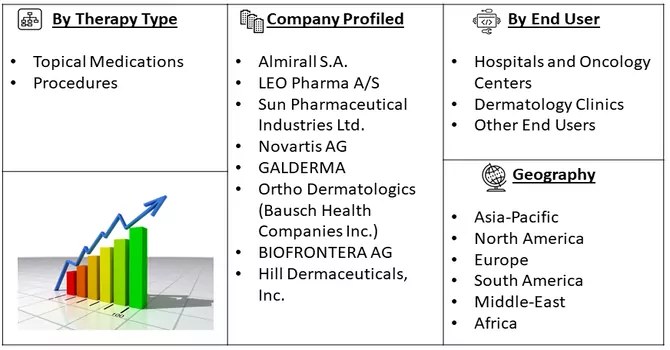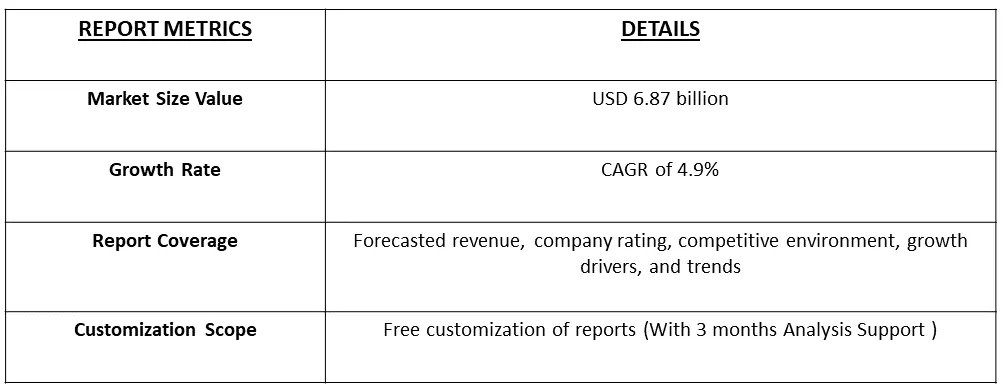The global market for actinic keratosis treatment was valued at USD 6.87 billion in 2022, with an expected compound annual growth rate (CAGR) of 4.9% from 2023 to 2030.

Get Complete Analysis Of The Report - Download Free Sample PDF
Actinic keratosis (AK) treatment refers to the therapeutic interventions and medical procedures aimed at addressing and resolving actinic keratosis, a common skin condition characterized by rough, scaly patches or lesions caused by prolonged exposure to ultraviolet (UV) radiation from the sun or artificial sources like tanning beds. Actinic keratosis is considered a precancerous condition, and appropriate treatment is essential to prevent its progression into skin cancer, particularly squamous cell carcinoma.
The increasing incidence of actinic keratosis is a primary driver for the growth of the treatment market. The prevalence of AK is on the rise, necessitating effective and accessible treatment options to address this dermatological condition. Also, the market benefits from the widespread availability of generic drugs designed for actinic keratosis treatment. The accessibility of these drugs enhances their adoption and contributes to the overall market expansion. Furthermore, growing awareness among consumers regarding dermatological conditions, specifically actinic keratosis, serves as a significant growth catalyst. As individuals become more informed about skin health, there is a heightened demand for effective treatments, driving market growth.
Market Segmentation: The Actinic Keratosis Treatment Market is segmented by Therapy Type (Topical Medications and Procedures), End User (Hospitals and Oncology Centers, Dermatology Clinics, and Other End Users), and Geography (North America, Europe, Asia-Pacific, Middle East and Africa, and South America). The report offers the value (in USD million) for the above segments.

For Detailed Market Segmentation - Download Free Sample PDF
The ongoing research and development efforts are focused on refining and introducing advanced topical therapies for actinic keratosis. Formulations with improved efficacy, patient compliance, and reduced side effects are becoming trends in the market. Also, combination therapies involving the use of multiple treatment modalities are becoming more prevalent. Combining topical agents, cryotherapy, and other interventions is aimed at addressing actinic keratosis more comprehensively and achieving better outcomes. In the end, immunotherapeutic approaches for actinic keratosis are gaining attention. Research is focused on understanding the role of the immune system in addressing precancerous skin conditions, leading to the development of novel immunotherapies. Thus, these market trends are expected to drive the growth of the studied market over the forecast period.
Market Drivers:
Increasing Prevalence of Actinic Keratosis Worldwide and Growing Demand for Minimally Invasive Procedures
The actinic keratosis treatment market is experiencing robust growth driven by several key factors, including the rising incidence of actinic keratosis, a growing preference for minimally invasive procedures, and intensified research and development efforts aimed at innovating therapeutic approaches. For instance, findings from the Indian Journal of Dermatology, published in April 2022, highlight actinic keratosis as a prevalent condition, diagnosed in over 10% of dermatology visits. In the UK, 15%-23% of individuals exhibit actinic keratosis lesions, with a notable increase to 37.5% among those aged 50 and above. This heightened prevalence underscores the imperative for early diagnosis and treatment, consequently driving the adoption of available therapies. Moreover, emerging treatment modalities are contributing to the market's expansion. According to an article in MDPI from June 2022, photodynamic therapy (PDT) utilizing 5-aminolevulinic acid (5-ALA) has emerged as a promising option in the care of actinic keratosis. The surge in actinic keratosis cases has led to a concurrent increase in the utilization of minimally invasive procedures, such as photodynamic therapy, indicating a positive trajectory for market growth in the foreseeable period. These factors collectively underline the dynamic landscape of the actinic keratosis treatment market, where a confluence of heightened disease prevalence, a preference for less invasive interventions, and ongoing research initiatives are propelling advancements in therapeutic options and fostering overall market expansion.
Strategic Development
In May 2023, the biotechnology firm FivepHusion unveiled a strategic collaboration with Syneos Health and Treehill Partners, marking a significant milestone in advancing the development of Deflexifol. This innovative pH formulation is designed for the concurrent administration of the chemotherapeutic agent 5-fluorouracil (5-FU) and the biomodulator leucovorin (LV), working synergistically to enhance the anti-cancer activity of 5-FU. Notably, 5-FU creams play a pivotal role in the topical treatment of actinic keratosis, a common skin condition associated with prolonged sun exposure. Beyond Deflexifol, various topical options are available for the treatment of actinic keratosis, each offering distinct advantages. These include diclofenac sodium gel, imiquimod cream, and tibanibulin ointment. The strategic partnership involving FivepHusion, Syneos Health, and Treehill Partners underscores a concerted effort to propel advancements in topical treatments for actinic keratosis, aiming to provide more effective and targeted therapeutic options for individuals affected by this dermatological condition. Through collaborative initiatives, this partnership signifies a commitment to addressing the evolving landscape of actinic keratosis treatment and enhancing the overall efficacy and patient experience in managing this skin disorder. Thus, these factors are expected to drive the growth of the studied market over the forecast period.
Market Restraints
Risk Factors Associated With Available Treatment Options
Actinic keratosis (AK) treatment involves a range of modalities, each with its own set of benefits and considerations. While these treatments aim to address AK effectively, it's crucial to recognize and navigate the associated risk factors to ensure informed decision-making in patient care. Topical treatments like 5-fluorouracil (5-FU), imiquimod, and diclofenac may cause local skin reactions such as redness, inflammation, and crusting. Patients with sensitive skin or a history of adverse reactions may be at a higher risk of experiencing these side effects. Thus, understanding the risk factors associated with available actinic keratosis treatment options is paramount for both healthcare providers and patients. A personalized approach, informed decision-making, and ongoing monitoring contribute to achieving optimal outcomes while minimizing potential adverse effects.
The actinic keratosis treatment market witnessed a notable impact from the COVID-19 pandemic, characterized by a significant reduction in the global performance of aesthetic procedures. This decline was a precautionary measure aimed at minimizing the risk of viral transmission. Notably, dermatologists played a crucial role during the crisis, focusing on managing cutaneous manifestations associated with COVID-19 and addressing occupational skin issues stemming from the prolonged use of personal protective equipment. The decrease in aesthetic procedures was primarily attributed to heightened concerns and apprehensions surrounding the potential risk of COVID-19 infection. As individuals sought to minimize in-person interactions, there was a shift in healthcare delivery methods. Telemedicine and teleconsultations emerged as viable alternatives, contributing to increased demand for dermatological treatments, including actinic keratosis treatment. Despite the initial challenges, the adoption of telemedicine proved instrumental in maintaining healthcare accessibility and addressing the needs of patients remotely.
This shift in patient behaviour, coupled with the convenience of virtual consultations, led to a resurgence in the demand for actinic keratosis treatment. As the global situation improved and COVID-19 cases declined, the pandemic's lasting impact on healthcare delivery became evident. The accelerated adoption of teledermatology continued, contributing to the stability and growth of the actinic keratosis treatment market. The blend of traditional and virtual healthcare approaches created a more resilient and adaptable landscape for dermatological care, ensuring that patients could access necessary treatments while prioritizing safety and minimizing the risk of infectious spread. Thus, the COVID-19 pandemic prompted a reevaluation of healthcare practices, fostering the integration of technology and remote care solutions. This transformative shift is expected to shape the trajectory of the actinic keratosis treatment market, with the resilience and versatility introduced during the pandemic influencing the market's stability and growth in the foreseeable future.
Segmental Analysis :
The Fluorouracil Segment is Expected to Witness Significant Growth Over the Forecast Period
Actinic keratosis (AK), a common skin condition induced by prolonged sun exposure, demands effective treatment to prevent its progression into more severe forms of skin cancer. Fluorouracil, commonly known as 5-FU, stands as a prominent and proven therapeutic agent in the arsenal of actinic keratosis treatments. Fluorouracil, with its well-established efficacy and targeted action on abnormal cells, remains a cornerstone in the treatment of actinic keratosis. Its ability to address both visible and subclinical lesions, coupled with a comprehensive approach to lesion elimination, positions Fluorouracil as a valuable and proven therapeutic option in dermatological care. The personalized application, monitoring, and patient education associated with Fluorouracil treatment contribute to its success in managing actinic keratosis effectively.
Hospitals and Oncology Centers Segment is Expected to Witness Significant Growth Over the Forecast Period
Actinic keratosis (AK), a common precancerous skin condition, demands specialized care, and hospitals and oncology centres play a pivotal role in providing comprehensive and advanced treatment options. Hospitals and oncology centres house a multidisciplinary team comprising dermatologists and oncologists. Dermatologists specialize in the diagnosis and management of skin conditions, including actinic keratosis, while oncologists contribute their expertise in addressing precancerous lesions and preventing malignancy. Thus, hospitals and oncology centres serve as the cornerstone of comprehensive actinic keratosis care. Through a collaborative and multidisciplinary approach, these healthcare institutions contribute to the early diagnosis, advanced treatment, and ongoing management of individuals with actinic keratosis, playing a crucial role in preventing its progression to more severe skin conditions.
North America Region is Expected to Witness Significant Growth Over the Forecast Period
North America is poised to be a significant player in the global actinic keratosis treatment market, driven by a combination of factors that underscore the region's demographic landscape and strategic initiatives by market players. North America faces a growing prevalence of actinic keratosis, particularly among the ageing population. The higher proportion of older individuals in this region is a noteworthy factor contributing to the increasing incidence of actinic keratosis. According to the 2021 America's Health Rankings data, the United States alone has over 54 million people aged 65 and above, constituting 16.5% of the total population. Projections indicate a substantial rise to an estimated 85.7 million adults aged 65 and older by the year 2050. Also, in Canada, a Statistics Canada update in April 2022 revealed that 1 in 5 Canadians (19%) were aged 65 and older, totalling 7 million individuals. The presence of approximately 25% of baby boomers (9.2 million) in 2021 further underscores the ageing demographic.
Furthermore, market players in North America are actively contributing to the growth through strategic launches. For instance, Almirall's introduction of tirbanibulin (Klisyri) for the topical treatment of actinic keratosis in the U.S. in February 2021 demonstrates a commitment to advancing treatment options.
Thus, North America emerges as a key player in the global actinic keratosis treatment market, propelled by a demographic landscape characterized by a growing ageing population. Strategic initiatives, innovative product launches, and collaborative efforts within the region contribute to a dynamic and expanding market that addresses the evolving healthcare needs of individuals with actinic keratosis.

Get Complete Analysis Of The Report - Download Free Sample PDF
The landscape of the actinic keratosis treatment market exhibits a moderate level of concentration, characterized by the presence of companies operating on both a global and regional scale. This composition underscores a diverse market structure with a mix of industry players contributing to the overall competitiveness and dynamics of the sector. The market features the participation of companies with a global reach, encompassing multinational corporations contributing to the broader market dynamics. Additionally, regional players operating within specific geographical areas contribute to the market's diversity. Some prominent players in the global actinic keratosis treatment market include:
Recent Developments:
1) In September 2022, PharmaEssentia Corporation received approval from Taiwan's Ministry of Health and Welfare (MOHW) for KX01 as the New Drug Application for Actinic Keratosis with the license number Wei-Bu-Yao-Shu-Zi No. 028364.
2) In May 2022, Actinic Keratosis Global Day was launched by Almirall in partnership with Euromelanoma and AEDV Fundación Piel Sana and coincided with Skin Cancer Awareness Month.
Q1. What was the Actinic Keratosis Treatment Market size in 2022?
As per Data Library Research the global market for actinic keratosis treatment was valued at USD 6.87 billion in 2022.
Q2. At what CAGR is the actinic keratosis treatment market projected to grow within the forecast period?
Actinic Keratosis Treatment Market is expected to grow compound annual growth rate (CAGR) of 4.9% over the forecast period.
Q3. What are the factors driving the Actinic Keratosis Treatment market?
Key factors that are driving the growth include the Increasing Prevalence of Actinic Keratosis Worldwide and Growing Demand for Minimally Invasive Procedures and Strategic Development.
Q4. Which region has the largest share of the Actinic Keratosis Treatment market? What are the largest region's market size and growth rate?
North America has the largest share of the market. For detailed insights on the largest region's market size and growth rate request a sample here.
Data Library Research are conducted by industry experts who offer insight on industry structure, market segmentations technology assessment and competitive landscape (CL), and penetration, as well as on emerging trends. Their analysis is based on primary interviews (~ 80%) and secondary research (~ 20%) as well as years of professional expertise in their respective industries. Adding to this, by analysing historical trends and current market positions, our analysts predict where the market will be headed for the next five years. Furthermore, the varying trends of segment & categories geographically presented are also studied and the estimated based on the primary & secondary research.
In this particular report from the supply side Data Library Research has conducted primary surveys (interviews) with the key level executives (VP, CEO’s, Marketing Director, Business Development Manager and SOFT) of the companies that active & prominent as well as the midsized organization
FIGURE 1: DLR RESEARH PROCESS

Extensive primary research was conducted to gain a deeper insight of the market and industry performance. The analysis is based on both primary and secondary research as well as years of professional expertise in the respective industries.
In addition to analysing current and historical trends, our analysts predict where the market is headed over the next five years.
It varies by segment for these categories geographically presented in the list of market tables. Speaking about this particular report we have conducted primary surveys (interviews) with the key level executives (VP, CEO’s, Marketing Director, Business Development Manager and many more) of the major players active in the market.
Secondary ResearchSecondary research was mainly used to collect and identify information useful for the extensive, technical, market-oriented, and Friend’s study of the Global Extra Neutral Alcohol. It was also used to obtain key information about major players, market classification and segmentation according to the industry trends, geographical markets, and developments related to the market and technology perspectives. For this study, analysts have gathered information from various credible sources, such as annual reports, sec filings, journals, white papers, SOFT presentations, and company web sites.
Market Size EstimationBoth, top-down and bottom-up approaches were used to estimate and validate the size of the Global market and to estimate the size of various other dependent submarkets in the overall Extra Neutral Alcohol. The key players in the market were identified through secondary research and their market contributions in the respective geographies were determined through primary and secondary research.
Forecast Model
